Related Research Articles

Johnny Weissmuller was an American Olympic swimmer, water polo player and actor. He was known for having one of the best competitive swimming records of the 20th century. He set world records alongside winning five gold medals in the Olympics. He won the 100m freestyle and the 4 × 200 m relay team event in the 1924 Summer Olympics in Paris and the 1928 Summer Olympics in Amsterdam. Weissmuller also won gold in the 400m freestyle, as well as a bronze medal in the water polo competition in Paris.

Cheeta is a chimpanzee character that appeared in numerous Hollywood Tarzan films of the 1930s–1960s, as well as the 1966–1968 television series, as the ape sidekick of the title character, Tarzan. Cheeta has usually been characterized as male, but sometimes as female, and has been portrayed by chimpanzees of both sexes.

Sam Katzman was an American film producer and director. Katzman's specialty was producing low-budget genre films, including serials, which had disproportionately high returns for the studios and his financial backers.
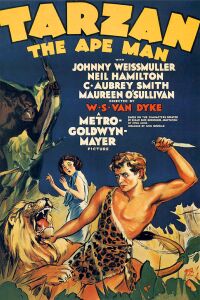
Tarzan the Ape Man is a 1932 pre-Code American action adventure film released by Metro-Goldwyn-Mayer featuring Edgar Rice Burroughs' famous jungle hero Tarzan and starring Johnny Weissmuller, Neil Hamilton, C. Aubrey Smith and Maureen O'Sullivan. It was Weissmuller's first of 12 Tarzan films. O'Sullivan played Jane in six features between 1932 and 1942. The film is loosely based on Burroughs' 1912 novel Tarzan of the Apes, with the dialogue written by Ivor Novello. The film was directed by W.S. Van Dyke. Metro-Goldwyn-Mayer released two remakes of Tarzan, the Ape Man in 1959 and in 1981, but each was a different adaptation of Rice Burroughs' novel. It is also the first appearance of Tarzan's famous yell.

Jungle Jim is the fictional hero of a series of jungle adventures in various media. The series began on January 7, 1934, as an American newspaper comic strip chronicling the adventures of Asia-based hunter Jim Bradley, who was nicknamed Jungle Jim. The character also trekked through radio, film, comic book and television adaptations. Notable was a series of films and television episodes in which Johnny Weissmuller portrayed the safari-suit wearing character, after hanging up his Tarzan loincloth. The strip concluded on August 8, 1954.

Jungle Jim in the Forbidden Land is a 1952 American black-and-white adventure film directed by Lew Landers and written by Samuel Newman, and starring Johnny Weissmuller as the title character. This was the eighth entry in Columbia's "Jungle Jim" series. Angela Greene and Jean Willes also star.

Jungle Manhunt is a 1951 adventure film written by Samuel Newman and directed by Lew Landers. It was the seventh entry in the "Jungle Jim" series of films starring Johnny Weissmuller as the title character. Based on the comic strip "Jungle Jim" created by Alex Raymond,
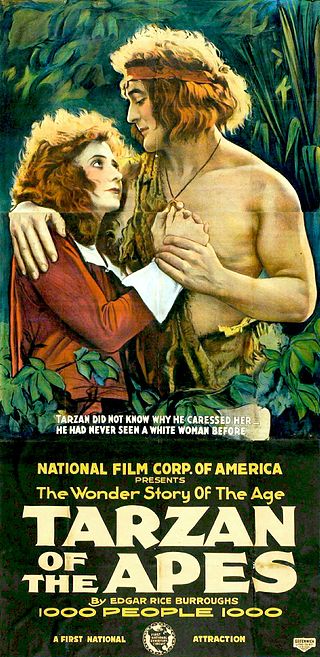
Tarzan, a fictional character created by Edgar Rice Burroughs, first appeared in the 1912 novel Tarzan of the Apes, and then in twenty-four sequels by Burroughs and numerous more by other authors. The character proved immensely popular and quickly made the jump to other media, first and most notably to comics and film.

Jungle Jim is a 1948 American adventure film directed by William Berke and starring Johnny Weissmuller. It is based on Alex Raymond's Jungle Jim comic strip and was distributed by Columbia Pictures. It is the first picture in the Jungle Jim series that consists of 16 films originally released between 1948 and 1955.
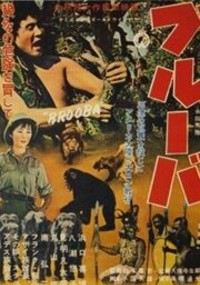
Brooba is a 1955 adventure film directed by Shigeyoshi Suzuki. The film was a Japanese Tarzan film based on the main character Brooba. It was supposed to be shot in the jungle but was filmed in Los Angeles. Like Johnny Weissmuller who starred in classic Tarzan films, the starring actor Yoshihiro Hamaguchi was also an Olympic swimming medalist in the 1952 Summer Olympics.

Devil Goddess (1955) is the sixteenth and final Jungle Jim film produced by Columbia Pictures. It features Johnny Weissmuller in his third and last performance as the protagonist adventurer Johnny Weissmuller, and his final film as well. It co-starred Ed Hinton and William Tannen as the film's antagonists, Leopold and Nels Comstock, respectively. Angela Stevens also stars. The film was directed by Spencer G. Bennet and written by Dwight Babcock and George H. Plympton.

Jungle Moon Men (1955) is the fifteenth Jungle Jim film produced by Columbia Pictures. It features Johnny Weissmuller in his second performance as the protagonist adventurer Johnny Weissmuller. The film was directed by Charles S. Gould and written by Dwight Babcock and Jo Pagano.
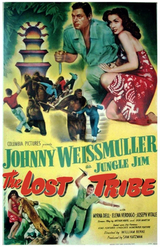
The Lost Tribe (1949) is the second Jungle Jim film produced by Columbia Pictures. The film features Johnny Weissmuller in his second performance as the adventurer Jungle Jim, co-starring Myrna Dell and Elena Verdugo, along with Joseph Vitale and George J. Lewis as the film's antagonists. It was directed by William Berke and written by Don Martin and Arthur Hoerl.

Fury of the Congo (1951) is the sixth Jungle Jim film produced by Columbia Pictures. It features Johnny Weissmuller in his sixth performance as the protagonist adventurer Jungle Jim. The film was directed by William Berke and written by Carroll Young.
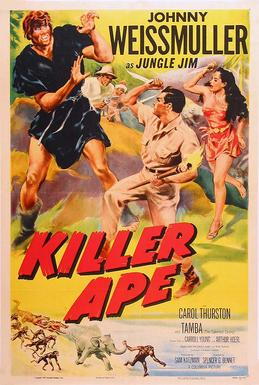
Killer Ape (1953) is the twelfth Jungle Jim film produced by Columbia Pictures. It features Johnny Weissmuller in his twelfth performance as the protagonist adventurer Jungle Jim. Carol Thurston also stars. The film was directed by Spencer G. Bennet and written by Arthur Hoerl and Carroll Young.
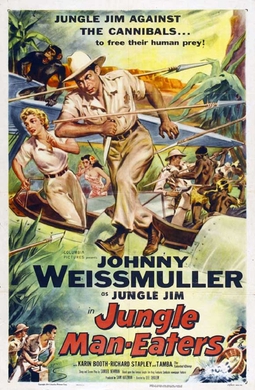
Jungle Man-Eaters is a 1954 American adventure film directed by Lee Sholem starring Johnny Weissmuller, Karin Booth and Richard Stapley. It was the last official Jungle Jim movie after Screen Gems bought the rights to make a TV series based on the character. With only three movies on his contract remaining, Weissmuller used them wisely by just playing himself, but the format stayed the same. Despite the title, there are no Jungle Man-Eaters shown in the film.
Savage Mutiny is a 1953 Jungle Jim film starring Johnny Weissmuller. It was the tenth entry in the series.

Captive Girl is the fourth Jungle Jim film produced by Columbia Pictures. It was directed by William Berke and starred Johnny Weissmuller as the title character. It was also Weissmuller's second teaming with his fellow former Tarzan and Olympic Gold Medal swimming champion Buster Crabbe after Swamp Fire (1946). The film was the only feature film appearance of Anita Lhoest who was a swimming champion and cellist.

Pygmy Island is a 1950 American Jungle Jim adventure film starring Johnny Weissmuller as the title character. It was movie number five in the series.
Jungle Jim is a 1955–56 American TV series based on the Jungle Jim newspaper comic strip. It stars Johnny Weissmuller, who had previously played the character in a series of sixteen theatrically released Jungle Jim feature films, which were produced soon after he retired from the Tarzan film series in 1948 for which he is best remembered.